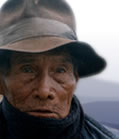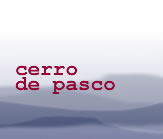Andrés was a member of the old Huaynacancha community which was abandoned because of extreme arsenic pollution from the foundry. His story illustrates the strength of community identity, and the changes in culture and livelihoods resulting from the mining industry. After living and working in different places he returned to found the new village, no longer based on agriculture but on commerce. He has been married twice and has five children who all live elsewhere.
He describes the old community, the impact of pollution and the slow recovery of the land. Members were dispersed and less than half the original number returned to found the new community. This has meant some loss of community identity and customs. Nevertheless, the pull of identity is strong eg he returned to serve his community as a leader.
He relates their struggles over compensation for their loss of livelihood, which was inadequate and only paid after several years. The community had to put in their own money, they bought unsuitable land and the terms of the agrarian reform settlement were unfavourable. They are now involved in a land dispute with farmhands on these lands.
|
You will need a password from Panos to view the full
transcript of the interview. To apply for a password, click here.
Once you have a password, click here to go to the beginning
of the transcript. You can also click on any section of the
breakdown of content below and go straight to the
corresponding part of the transcript.
|
| Section 1 |
Information on life in old Huaynacancha, especially about agriculture and pollution from the foundry. Community had 50 comunero (registered community member with rights and responsibilities) families, school, church, council...
|
| Section 2 |
The community abandoned Huaynacancha because of pollution arsenic dust: animals and pastures suffered.
His family went to Ticlio, as father worked on the railway (ENAFER PERU).
|
| Section 3 |
Father worked in Llocllapampa and became a member of community with access to a house in return for community work. Andrés went to primary school there.
Father and he helped with sowing and harvesting and then worked on the new Oroya-Juaja road. He became a track worker at 16 and then a mechanic with ENAFER in La Oroya.
Filters have reduced pollution, but in the old village vegetation is still sparse: no good for settlement.
|
| Section 4 |
Account of agrarian reform and their claim for land for new village.
Livelihoods now depend on trading on the main road rather than agriculture. Managed to harvest a little barley, but only larger livestock will eat it.
Small compensation from Cerro de Pasco for the pollution and loss of livelihood, but this compensation was to stretch over 20 years. Community tried to get it in a lump sum to buy new land. Tells how they were tricked by the company. Only years later they bought land for security but too far away to be useful
|
| Section 5 |
Each member paid an individual quota giving them proportionate rights to the land. Only bought it for security and now they're in dispute with the farmworkers they allowed to stay on the estate.
|
| Section 6 |
New Huaynacancha: not enough land for farming, only for dwellings and some communal grazing. No individual animals are permitted by law. He has some sheep on the communal land. Only sufficient grazing for 150 sheep.
Environmental problems - water is polluted with minerals and lime and is scarce.
|
| Section 6-7 |
Centromín no longer pays compensation and still cause pollution. They feel unable to beat the lawyers.
|
| Section 7 |
Account of the pain of leaving the ancestral lands over which they're still fighting. Problem of breaking up of families and the community.
First wife died and he's married again. Children from first marriage only: they're all in Lima for work and studies, apart from one daughter working in Oroya. She worked for the Ministry of Agriculture and represents the Agrarian League.
|
| Section 7-8 |
Young people tend to move away as there is no future around here.
|
| Section 8 |
He has held several leadership posts in the community, some new posts have been added. He came back to the community specifically to be their treasurer.
|
| Section 9 |
Retired from community responsibilities as he felt old and tired after a very hard life. Strong attachment to the old community: feelings for new one not so strong.
Customs - only civil marriages in Huaynacancha, religious ones elsewhere
Fiesta (festival, celebration) of the founding of the new village: 16th June.
|
| Section 10 |
This has replaced the old patron saint fiesta of the Virgin Mary. Description of event - games, races, etc.
Loss of customs, stemming from the uprooting of the village and death of the old folk. New community founded by 20 men. Only 8 left now: the rest of the village are outsiders. People work in transport or live from pensions and small animals. Sometimes people drink to forget the difficulties
|
| Section 11 |
Hints at human casualties from the pollution but difficult to prove as they all went to different places: “we had to be nomads”.
He has no more family, uncle died. Father died of bronchitis whilst working for Cerro de Pasco
Fumes caused eye irritation in Oroya but not so bad now. Cites tuberculosis as a result of pollution.
|
| Section 12 |
Animals diseases treated with paraffin and white spirit
Complains of no local money to build up the new community, but government recently put in water and sewage system
Recap of the land settlement, they paid for part of it – several thousand soles.
|
| Section 13 |
Customs have been lost because of the uprooting. Talks of their resistance and determination to move on and live in poverty but with dignity.
|


